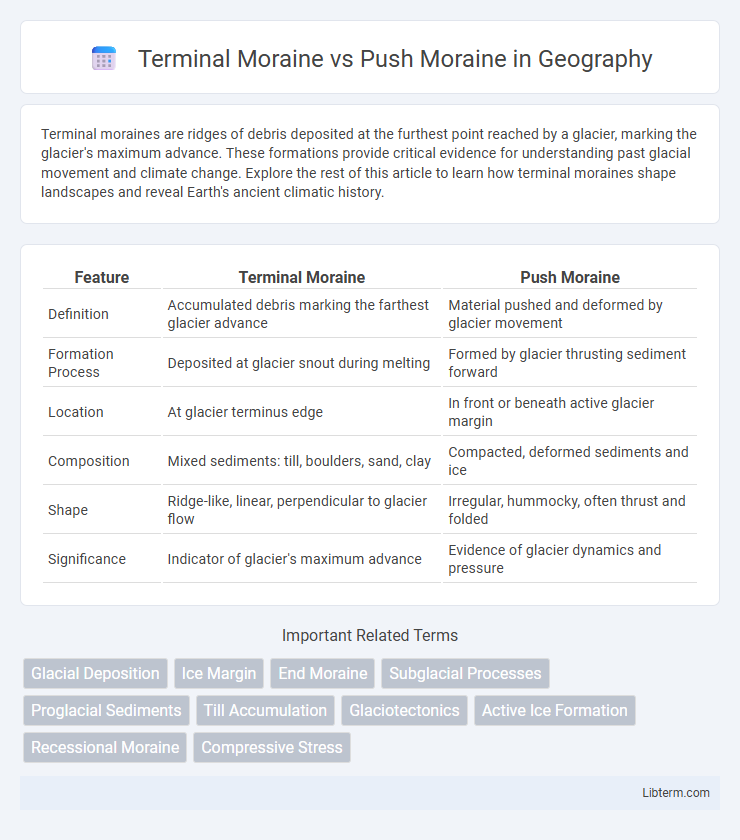Terminal moraines are ridges of debris deposited at the furthest point reached by a glacier, marking the glacier's maximum advance. These formations provide critical evidence for understanding past glacial movement and climate change. Explore the rest of this article to learn how terminal moraines shape landscapes and reveal Earth's ancient climatic history.
Table of Comparison
| Feature | Terminal Moraine | Push Moraine |
|---|---|---|
| Definition | Accumulated debris marking the farthest glacier advance | Material pushed and deformed by glacier movement |
| Formation Process | Deposited at glacier snout during melting | Formed by glacier thrusting sediment forward |
| Location | At glacier terminus edge | In front or beneath active glacier margin |
| Composition | Mixed sediments: till, boulders, sand, clay | Compacted, deformed sediments and ice |
| Shape | Ridge-like, linear, perpendicular to glacier flow | Irregular, hummocky, often thrust and folded |
| Significance | Indicator of glacier's maximum advance | Evidence of glacier dynamics and pressure |
Introduction to Terminal and Push Moraines
Terminal moraines mark the furthest advance of a glacier, composed of debris deposited at the glacier's snout during its maximum extent. Push moraines form when a glacier advances and physically pushes accumulated sediments forward, creating ridges without significant melting or retreat. These distinct formations provide critical insights into glacial dynamics and past climatic conditions.
Definition of Terminal Moraine
A terminal moraine is a glacial landform composed of debris deposited at the furthest point reached by a glacier, marking its maximum advance. Unlike a push moraine, which forms when a glacier actively bulldozes sediment forward, a terminal moraine represents the stable boundary where glacial ice has paused during retreat. These moraines often appear as prominent ridges or hills composed of unsorted till and provide key indicators of past glacial movement and extent.
Definition of Push Moraine
A push moraine forms when advancing glaciers actively thrust and pile up sediment and debris, causing the landscape to deform with a distinctive ridged appearance. Unlike terminal moraines, which mark the furthest advance of a glacier's snout, push moraines indicate multiple phases of glacial advance and compress the underlying materials. This process results in intricate landforms that provide valuable evidence of past glacial dynamics and climatic conditions.
Formation Processes of Terminal Moraine
Terminal moraines form at the furthest advance of a glacier, marking the maximum extent of glacial movement as debris accumulates and compacts at the glacier's snout during stationary phases. This accumulation results from the glacier's forward push transporting rock, soil, and sediment, which deposits as the ice melts and retreats. In contrast, push moraines arise from glacier re-advancement that thrusts previously deposited sediments forward, reshaping the moraine landscape.
Formation Processes of Push Moraine
Push moraines form when advancing glaciers physically shove and deform underlying sediments, creating accumulations of till that are pushed forward into ridges. Unlike terminal moraines, which mark the furthest extent of glacier advance and result from sediment deposited at the glacier's snout during melting, push moraines result primarily from the mechanical thrusting action of ice movement. This process involves compressional stress that squeezes and uplifts pre-existing sediments, distinguishing push moraines by their pronounced deformation structures.
Key Differences Between Terminal and Push Moraines
Terminal moraines mark the furthest advance of a glacier, formed from debris accumulated at its snout during maximum glacial extension. Push moraines develop when a glacier actively pushes previously deposited sediments forward, creating ridges from reworked materials rather than original deposition. Key differences include their formation processes--terminal moraines result from glacier retreat deposits, whereas push moraines form from mechanical deformation and thrusting of sediments by glacier movement.
Geographical Distribution and Examples
Terminal moraines are commonly found at the furthest point of glacier advance, marking the maximum glacier extent, with notable examples like the Long Island terminal moraine in the northeastern United States. Push moraines occur where active glacier ice physically pushes and deforms previously deposited sediment, often found in dynamic glacier margins such as those in the Swiss Alps. Geographic distribution of terminal moraines spans across formerly glaciated regions in North America, Europe, and Asia, whereas push moraines are more localized to areas with active, advancing glaciers.
Geological Significance and Impacts
Terminal moraines mark the furthest advance of glaciers, providing critical evidence for reconstructing past ice extents and understanding climate fluctuations during glacial periods. Push moraines form when glaciers actively bulldoze and deform sediments, offering insights into glacial dynamics and sedimentary processes. Both features significantly influence landscape evolution by altering drainage patterns and soil distribution in glaciated regions.
Role in Glacial Landscape Evolution
Terminal moraines mark the furthest advance of a glacier, forming ridges that delineate past ice margins and influence subsequent drainage patterns and sediment distribution. Push moraines develop when advancing ice bulldozes underlying sediment forward, reshaping the landscape by creating irregular, hummocky terrain and altering soil stratigraphy. Both features play critical roles in glacial landscape evolution by preserving evidence of glacier dynamics and directing post-glacial ecological succession.
Summary: Terminal Moraine vs Push Moraine
Terminal moraines form at the furthest point of a glacier's advance, marking the maximum extent of ice movement and consisting of accumulated debris deposited as the glacier retreats. Push moraines result from the glacier actively pushing previously deposited sediments forward, creating ridges of deformed material. The key difference lies in terminal moraines representing standstill positions of ice margin, while push moraines are formed by dynamic ice movement and sediment displacement.
Terminal Moraine Infographic

 libterm.com
libterm.com